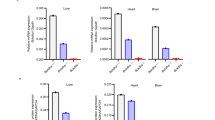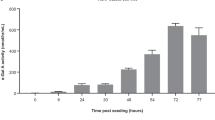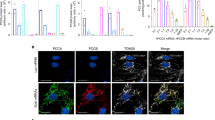Abstract
Ornithine transcarbamylase deficiency (OTCD) is the most common inborn error of urea synthesis. Complete OTCD can result in hyperammonemic coma in the neonatal period, which can rapidly become fatal. Current acute therapy involves dialysis; chronic therapy involves the stimulation of alternate nitrogen clearance pathways; and the only curative approach is liver transplantation. Adeno-associated virus (AAV) vector-based gene therapy would add to current treatment options provided the vector delivers high level and stable transgene expression in liver without dose-limiting toxicity. In this study, we employed an AAV2/8-based self-complementary (sc) vector expressing the murine OTC (mOTC) gene under a liver-specific thyroxine-binding globulin promoter and examined the therapeutic effects in a mouse model of OTCD, the spf ash mouse. Seven days after a single intravenous injection of vector, treated mice showed complete normalization of urinary orotic acid, a measure of OTC activity. We further improved vector efficacy by incorporating a Kozak or Kozak-like sequence into mOTC complementary DNA, which increased the OTC activity by five or twofold and achieved sustained correction of orotic aciduria for up to 7 months. Our results demonstrate that vector optimizations can significantly improve the efficacy of gene therapy.
This is a preview of subscription content, access via your institution
Access options
Subscribe to this journal
Receive 12 print issues and online access
$259.00 per year
only $21.58 per issue
Buy this article
- Purchase on Springer Link
- Instant access to full article PDF
Prices may be subject to local taxes which are calculated during checkout






Similar content being viewed by others
References
Batshaw ML, MacArthur RB, Tuchman M . Alternative pathway therapy for urea cycle disorders: twenty years later. J Pediatr 2001; 138: S46–S54; discussion S54–45.
Krivitzky L, Babikian T, Lee HS, Thomas NH, Burk-Paull KL, Batshaw ML . Intellectual, adaptive, and behavioral functioning in children with urea cycle disorders. Pediatr Res 2009; 66: 96–101.
Leonard JV, McKiernan PJ . The role of liver transplantation in urea cycle disorders. Mol Genet Metab 2004; 81 (Suppl 1): S74–S78.
Ye X, Robinson MB, Batshaw ML, Furth EE, Smith I, Wilson JM . Prolonged metabolic correction in adult ornithine transcarbamylase-deficient mice with adenoviral vectors. J Biol Chem 1996; 271: 3639–3646.
Ye X, Robinson MB, Pabin C, Quinn T, Jawad A, Wilson JM et al. Adenovirus-mediated in vivo gene transfer rapidly protects ornithine transcarbamylase-deficient mice from an ammonium challenge. Pediatr Res 1997; 41: 527–534.
Raper SE, Wilson JM, Yudkoff M, Robinson MB, Ye X, Batshaw ML . Developing adenoviral-mediated in vivo gene therapy for ornithine transcarbamylase deficiency. J Inherit Metab Dis 1998; 21 (Suppl 1): 119–137.
Yang Y, Ertl HC, Wilson JM . MHC class I-restricted cytotoxic T lymphocytes to viral antigens destroy hepatocytes in mice infected with E1-deleted recombinant adenoviruses. Immunity 1994; 1: 433–442.
Yang Y, Nunes FA, Berencsi K, Furth EE, Gonczol E, Wilson JM . Cellular immunity to viral antigens limits E1-deleted adenoviruses for gene therapy. Proc Natl Acad Sci USA 1994; 91: 4407–4411.
Raper SE, Chirmule N, Lee FS, Wivel NA, Bagg A, Gao GP et al. Fatal systemic inflammatory response syndrome in a ornithine transcarbamylase deficient patient following adenoviral gene transfer. Mol Genet Metab 2003; 80: 148–158.
Alexander IE, Cunningham SC, Logan GJ, Christodoulou J . Potential of AAV vectors in the treatment of metabolic disease. Gene Therapy 2008; 15: 831–839.
Gao GP, Alvira MR, Wang L, Calcedo R, Johnston J, Wilson JM . Novel adeno-associated viruses from rhesus monkeys as vectors for human gene therapy. Proc Natl Acad Sci USA 2002; 99: 11854–11859.
McCarty DM . Self-complementary AAV vectors; advances and applications. Mol Ther 2008; 16: 1648–1656.
Moscioni D, Morizono H, McCarter RJ, Stern A, Cabrera-Luque J, Hoang A et al. Long-term correction of ammonia metabolism and prolonged survival in ornithine transcarbamylase-deficient mice following liver-directed treatment with adeno-associated viral vectors. Mol Ther 2006; 14: 25–33.
Cunningham SC, Spinoulas A, Carpenter KH, Wilcken B, Kuchel PW, Alexander IE . AAV2/8-mediated correction of OTC deficiency is robust in adult but not neonatal Spf(ash) mice. Mol Ther 2009; 17: 1340–1346.
Loeb JE, Cordier WS, Harris ME, Weitzman MD, Hope TJ . Enhanced expression of transgenes from adeno-associated virus vectors with the woodchuck hepatitis virus posttranscriptional regulatory element: implications for gene therapy. Hum Gene Ther 1999; 10: 2295–2305.
Mian A, McCormack Jr WM, Mane V, Kleppe S, Ng P, Finegold M et al. Long-term correction of ornithine transcarbamylase deficiency by WPRE-mediated overexpression using a helper-dependent adenovirus. Mol Ther 2004; 10: 492–499.
Paterna JC, Moccetti T, Mura A, Feldon J, Bueler H . Influence of promoter and WHV post-transcriptional regulatory element on AAV-mediated transgene expression in the rat brain. Gene Therapy 2000; 7: 1304–1311.
Kingsman SM, Mitrophanous K, Olsen JC . Potential oncogene activity of the woodchuck hepatitis post-transcriptional regulatory element (WPRE). Gene Therapy 2005; 12: 3–4.
Wang L, Wang H, Bell P, McCarter RJ, He J, Calcedo R et al. Systematic evaluation of AAV vectors for liver directed gene transfer in murine models. Mol Ther 2010; 18: 118–125.
Bell P, Gao G, Haskins ME, Wang L, Sleeper MM, Wang H et al. Evaluation of AAV Vectors for Liver-directed Gene Transfer in Dogs. Hum Gene Ther (in press).
Wang L, Calcedo R, Wang H, Bell P, Grant R, Vandenberghe LH et al. The pleiotropic effects of natural AAV infections on liver-directed gene transfer in macaques. Mol Ther 2010; 18: 126–134.
Nathwani AC, Gray JT, Ng CY, Zhou J, Spence Y, Waddington SN et al. Self-complementary adeno-associated virus vectors containing a novel liver-specific human factor IX expression cassette enable highly efficient transduction of murine and nonhuman primate liver. Blood 2006; 107: 2653–2661.
Wu Z, Sun J, Zhang T, Yin C, Yin F, Van Dyke T et al. Optimization of self-complementary AAV vectors for liver-directed expression results in sustained correction of hemophilia B at low vector dose. Mol Ther 2008; 16: 280–289.
Wang Z, Ma HI, Li J, Sun L, Zhang J, Xiao X . Rapid and highly efficient transduction by double-stranded adeno-associated virus vectors in vitro and in vivo. Gene Therapy 2003; 10: 2105–2111.
Nathwani AC, Gray JT, McIntosh J, Ng CY, Zhou J, Spence Y et al. Safe and efficient transduction of the liver after peripheral vein infusion of self-complementary AAV vector results in stable therapeutic expression of human FIX in nonhuman primates. Blood 2007; 109: 1414–1421.
Morizono H, Tuchman M, Rajagopal BS, McCann MT, Listrom CD, Yuan X et al. Expression, purification and kinetic characterization of wild-type human ornithine transcarbamylase and a recurrent mutant that produces ‘late onset’ hyperammonaemia. Biochem J 1997; 322 (Part 2): 625–631.
Sondhi D, Hackett NR, Peterson DA, Stratton J, Baad M, Travis KM et al. Enhanced survival of the LINCL mouse following CLN2 gene transfer using the rh.10 rhesus macaque-derived adeno-associated virus vector. Mol Ther 2007; 15: 481–491.
Bell P, Moscioni AD, McCarter RJ, Wu D, Gao G, Hoang A et al. Analysis of tumors arising in male B6C3F1 mice with and without AAV vector delivery to liver. Mol Ther 2006; 14: 34–44.
Acknowledgements
We thank Martin Lock, Julie Johnston, Arbans Sandhu, and Shu-Jen Chen (Penn Vector) for supplying vectors, Guangping Gao and Xun Sun for initial participation of the project. This work was supported in part by the Kettering Family Foundation and the following Grants to JMW: P01-HD057247, P01-HL059407 and P30-DK047757. HW was supported by a scholarship from China Scholarship Council.
Author information
Authors and Affiliations
Corresponding author
Ethics declarations
Competing interests
JMW is a consultant to ReGenX Holdings, and is a founder of, holds equity in and receives a grant from affiliates of ReGenX Holdings; in addition, he is an inventor on patents licensed to various biopharmaceutical companies, including affiliates of ReGenX Holdings.
Rights and permissions
About this article
Cite this article
Wang, L., Wang, H., Morizono, H. et al. Sustained correction of OTC deficiency in spfash mice using optimized self-complementary AAV2/8 vectors. Gene Ther 19, 404–410 (2012). https://doi.org/10.1038/gt.2011.111
Received:
Accepted:
Published:
Issue Date:
DOI: https://doi.org/10.1038/gt.2011.111
Keywords
This article is cited by
-
The LOX-1 receptor ectopically expressed in the liver alleviates atherosclerosis by clearing Ox-LDL from the circulation
Molecular Medicine (2022)
-
Gene delivery corrects N-acetylglutamate synthase deficiency and enables insights in the physiological impact of L-arginine activation of N-acetylglutamate synthase
Scientific Reports (2021)
-
A dual AAV system enables the Cas9-mediated correction of a metabolic liver disease in newborn mice
Nature Biotechnology (2016)
-
In Vivo Selection of Transplanted Hepatocytes by Pharmacological Inhibition of Fumarylacetoacetate Hydrolase in Wild-type Mice
Molecular Therapy (2012)



